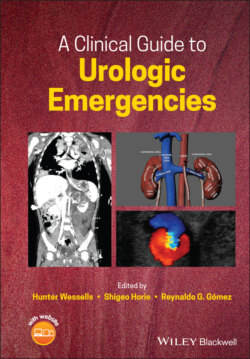Читать книгу A Clinical Guide to Urologic Emergencies - Группа авторов - Страница 41
Imaging
ОглавлениеThe goals of imaging are to grade the renal injury, identify injuries to other organs, and demonstrate the presence of a functioning contralateral kidney should operative management be necessary. The stability of the patient determines the initial imaging; unstable patients cannot obtain computed tomography (CT) scans if they require immediate intervention and the kidneys and retroperitoneum can be assessed in the operating room at time of laparotomy. In military trauma, due to forward deployment of combat support hospitals and the technological progression of expeditionary medicine, CT capabilities are available in war zones and the imaging principles remain congruent with civilian trauma [23].
All stable patients with penetrating abdominal trauma should get diagnostic imaging with IV contrast enhanced CT. To fully evaluate and stage renal trauma (Table 2.1), the American Urological Association (AUA) and European Association of Urology (EAU) recommend a three‐phase CT [24, 25]:
1 Arterial phase: to assess for vascular injury and active contrast extravasation
2 Nephrographic phase: to demonstrate parenchymal contusions and lacerations
3 Delayed phase: to identify collecting system injury.
In clinical practice, however, whole‐body trauma imaging is often obtained prior to the involvement of the urologist and delayed phase imaging is not routinely performed. As the optimal timing for delayed phase imaging is 9–10 minutes after contrast injection, another CT can be performed without repeat IV contrast injection if performed within this time window [26]. If there is a PRI on initial imaging and delayed phase imaging was not obtained, a repeat CT with delayed phase imaging is still recommended and can be performed with low risk of contrast‐induced nephropathy [27].
The American Association for the Surgery of Trauma (AAST) organ injury scale is the most commonly‐used tool to grade traumatic solid organ injuries. The AAST staging for renal trauma is shown in Table 2.1. Although it was not originally designed to be a prognostic tool, studies have shown good correlation between higher‐grade renal injuries and need for surgical intervention, such as nephrectomy [28, 29].
Findings on CT that are risk factors for hemorrhage and need for urgent invasive intervention are hematoma with a diameter greater than 3.5 cm, medial renal laceration, and intravascular contrast extravasation. In patients with two or more of these risk factors, the risk of intervention to control bleeding was 66.7% [30].
For higher‐grade renal lacerations (Grade IV–V), penetrating trauma, or patients experiencing complications (fever, ileus, etc.), both the AUA and EAU recommend repeat CT imaging two to four days after the initial trauma, because these are prone to developing complications from their initial injury, such as urinoma or persistent bleeding [24, 25].
